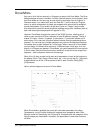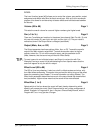
Editing Programs: Chapter 6
LEVEL
The Level function (press [40]) allows you to control the volume, pan position, output
assignment and effects send level for each sound layer. With up to four sounds per
program, this allows for a wide variety of stereo effects and level balances between
the sounds.
Volume (00 to 99) Page 1
This sets the overall volume for a sound. Higher numbers give higher levels.
Pan (<3 to 3>) Page 2
There are 7 available pan locations in the stereo (two-channel) field: Far left (-3), mid
left, near left, center (0), near right, mid right, and far right (+3). The pan value is
maintained, even if the Output value is changed (see below).
Output (Main, Aux, or Off) Page 3
The Output parameter has three settings: Main, Aux, or Off. To send the sound’s
output to the Main outputs, select Main. To send the sound’s output to the Aux
outputs, select Aux. To turn off the sound’s output, set this parameter to Off.
(Note, however, that the sound may still feed an Effect Send).
TIP:
To send a sound to an individual output, use Output in conjunction with Pan.
Example: Panning a sound full left and selecting the Aux outputs means that the
sound will appear at only the left Aux output.
Effect Level (00 to 99) Page 4
The QS isn’t just a synthesizer; it also has a built-in effects system and mixer, with
four effect buses and sends. This section lets you feed the sound to one of the effect
buses for processing (see Chapter 7 for more information on editing Effects). The
Effect Level parameter determines how much of the sound feeds the chosen effect
bus (see below). Higher values mean that the sound will be more effected.
Effect Bus (1 to 4) Page 5
Selects which of the four buses the sound will feed, thereby determining which
effect(s) will process the sound. Each Program has its own unique arrangement of
effects. Example: In Program #12, bus 1 may be a Chorus/Delay/Reverb, while in
Program #27, bus 1 may just be a Flanger.
QS7/QS8 Reference Manual 57


















